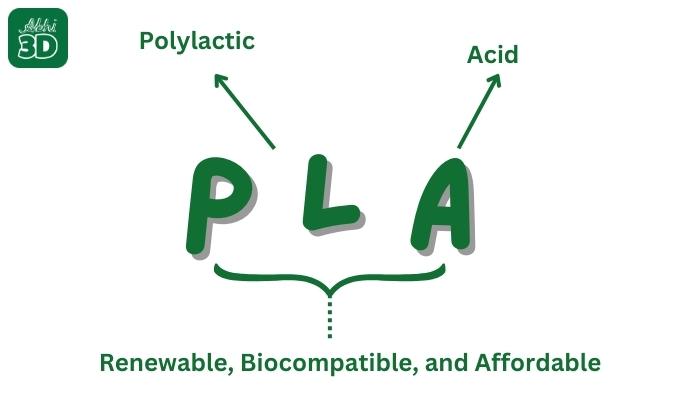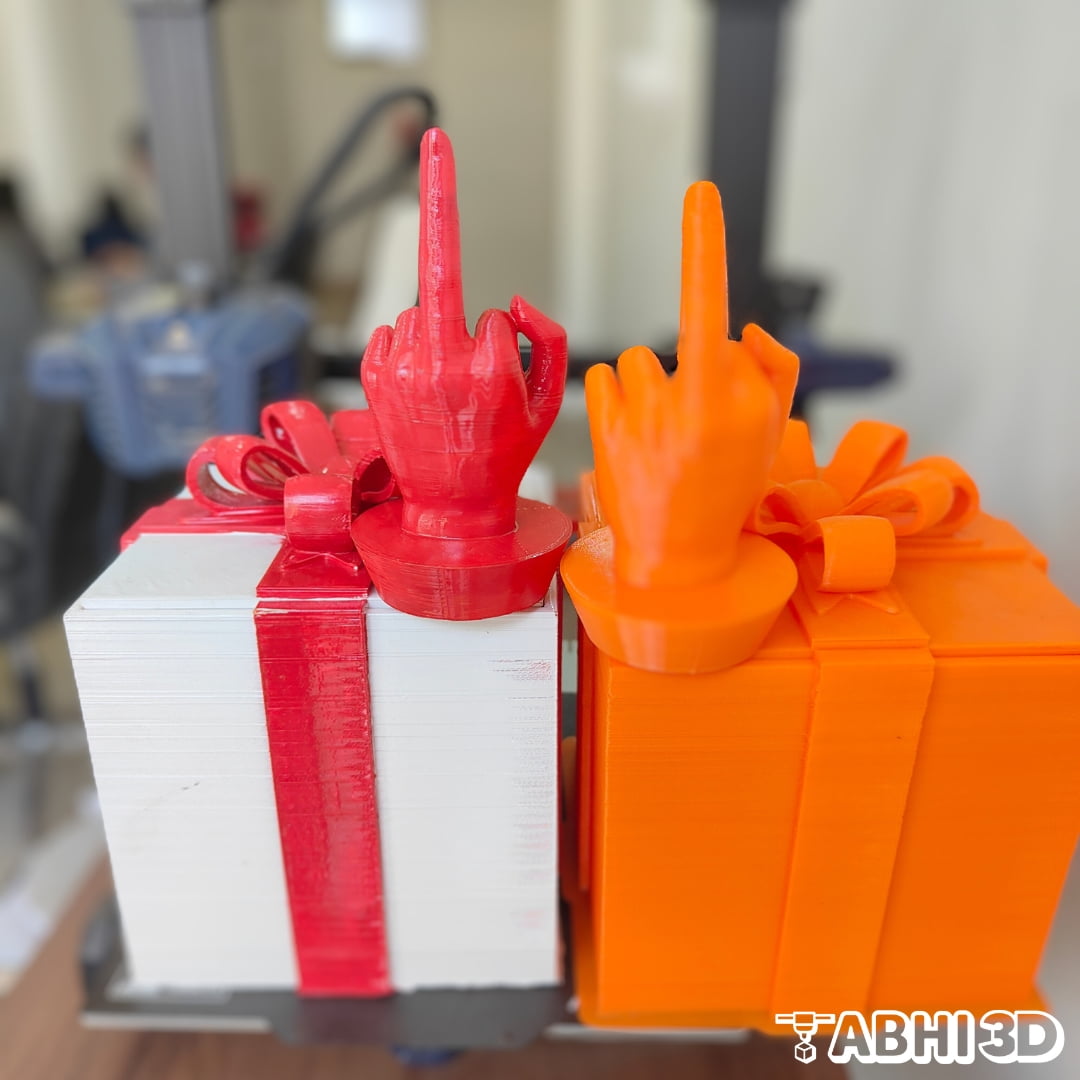PLA stands for polylactic acid and is the most widely used Filament for 3D printing. It is easy to use, affordable, and great for maybe 90% of the things that you’d want to print as a beginner. In fact, for many people, it’s the only printing material they’ll ever use to 3D print objects.

PLA is easy to print with relatively low temperatures, it will stick well enough to most bed surfaces and 3D prints are actually quite strong. Most affordable 3D printing machines are optimized specifically for PLA.
Table Of Contents
Understanding Polylactic Acid Polymer:
Polylactic acid is renewable, biocompatible, and a biodegradable polymer that has good mechanical and optical properties, and is one of the most widely used bioplastics. Its low melting point, high rigidity, scalable production, and affordable cost make it the favorite filament for 3D printing. In 2021, PLA actually had the highest consumption of any bioplastic in the world.

Qualities Of PLA Filament:
PLA certainly has many qualities which makes it the most widely used Filament in 3D printing. Here let’s see all of them one by one:
Low Melting Point:
PLA doesn’t like heat, and while you might think to yourself that its melting point is high enough, somewhere around 190 degrees for printing. The fact is that it will begin to deform at a much lower temperature.

Wide Variety Of Color Option Available:
PLA has a wide availability of different colors and styles ranging from your standard PLAs to matte or silk, rainbow silk, gradient multi-color, and much, much more. PLA really is the champion for printing anything decorative, such as statues, toys, and so on.

Gradient Multi-Color PLA Are In Trends:
People really like PLA filament which comes in multiple colors that blend together. It’s a great choice for creating amazing 3D-printed objects. This type of PLA filament is quite popular and a favorite among 3D artists.

Affordable Cheap PLA Filament:
PLA filament can cost from $15 to $400 for a 1.75 mm thick 1KG spool, which is enough for 3D printing. This means you can get started with 3D printing for just $15. It’s great for beginners who want to try 3D printing. Surprisingly, the cheap PLA filament is pretty good. In fact, they are so good that most people will only be using cheap filament for their whole life because it’s affordable and makes strong and clean prints.

High Rigidity:
PLA filament prints objects that are strong and sturdy. I know some will argue and say materials like ABS, PETG, etc are much more stronger. I will say, that you are right too but considering its popularity/affordable cost PLA filament makes durable objects that won’t easily break. It’s still a good choice when you want your 3D prints to be tough and last a long time.

Environment Friendly:
PLA filament is environmentally friendly due to its biodegradability and use of renewable resources like corn and sugarcane. It has a lower carbon footprint and reduces our dependence on fossil fuels. PLA is non-toxic, recyclable, and requires less energy for 3D printing, making it a sustainable choice for various applications. However, proper disposal is crucial to maximize its eco-friendliness.

Pros And Cons Of PLA Filament:
| Pros | Cons |
|---|---|
| Easy to Use: PLA is beginner-friendly and quite popular. | Not Super Strong: PLA isn’t as tough as some other materials like ABS, so it’s not great for everything. |
| Less Warping: PLA is less likely to bend out of shape while you’re printing, so it’s reliable. | Sensitive to Heat: It can get soft and change shape in high heat, so it’s not good for hot places. |
| Lots of Colors: You can get PLA in many bright colors for your 3D prints. | Kind of Brittle: PLA might snap or break more easily. |
| Eco-Friendly: It’s made from natural stuff and can break down, which is good for the Earth. | Not for Outside: It’s not the best for outdoor things because it can get damaged by the sun. |
PLA+:
PLA is still the most common 3D printing material but is often not suitable for every application due to its brittleness and bad thermal performance. To tackle this downside companies have come up with PLA+ which is tougher compared to regular PLA filament. So, if you want your 3D prints to be tougher and flexible, PLA+ might be a good option for you.

You can read our full guide on PLA+ filament here
How To Choose The Best PLA Filament For 3D Printing:
It totally depends on your requirements. If you are new to 3D printing, just go to Amazon, check reviews, and choose any cheap Filament. It’s a good way to start. But if you want to be more selective then you will need to make a choice keeping the below factors in mind:
Strength & Durability:
Many brands have upgraded PLA and sold it with names like PLA+ or PLA Pro. In these upgraded options, they have improved strength, rigidity, and overall toughness. So, I recommend using PLA+ or PLA Pro filament if you are looking for greater strength in your 3D prints.
Colors:
PLA comes in a variety of colors, offering you numerous options to choose from. If you are very selective, be prepared for certain multi-color options to be available with specific brands only. Also, expect multi-blended color PLA filament to cost more compared to regular single-color PLA filament.
Dimensional Accuracy:
To understand dimensional accuracy in 3D printing, let’s take an example of a cube. You design it on your computer, and the design is perfect, with all the sides measuring exactly 2 centimeters. You’re expecting a perfect 2x2x2 cm cube to come out of your 3D printer. But here’s the thing, sometimes the real-life print doesn’t match your design exactly. That’s where dimensional accuracy comes into play.

Dimensional accuracy is all about how closely the actual 3D-printed object matches what you designed on your computer. In our example, if your printed cube measures exactly 2x2x2 cm, it’s considered dimensionally accurate. But sometimes, it might turn out to be a little bigger or smaller.
Why does this happen? Well, PLA filament can behave differently when it’s heated and then cools down. It might expand a tiny bit when it’s hot, and then shrink a bit as it cools. This can lead to a slightly different size in your printed object compared to your design.
So, when you’re 3D printing something, it’s important to keep an eye on dimensional accuracy, especially if you need your printed objects to fit together precisely.
Most PLA filament dimensional accuracy comes in the range of +/- 0.02 mm to +/- 0.06 mm. Here you can make your choice based on your 3D print requirement. A lower tolerance number, like +/- 0.02mm, means the filament is more consistent in size, which is good for 3D printing.
Printing Material Requirement:
PLA filament is like your building blocks for 3D printing, but there are some special kinds. First, there’s regular PLA, which is like your standard printing material for most projects. Then, there’s PLA+, which is a stronger and more durable version of PLA, ideal for tougher creations. If you need lightweight pieces, there’s lightweight PLA, perfect for things like drones. High-temperature PLA can handle heat, while flexible PLA is like building things that can bend. Soft PLA is squishy and great for comfy items. Wood-filled PLA has real wood mixed in for a woody look, and marble PLA gives a fancy, marbled appearance. So, you can pick the right filament for your 3D printing to fulfill your needs.

When To Use PLA Filament:
PLA filament is like a special kind of thread you use in a 3D printer to create things. Now, let’s talk about when it’s a good choice:

When You’re Starting Out: PLA is a great choice for beginners. It’s like the easiest crayon to draw with when you’re learning to draw. It’s simple to work with and doesn’t require any fancy settings.
When You Want Colorful Creations: If you like making colorful 3D prints, PLA is like the rainbow of 3D printing. You can find it in lots of colors, just like crayons, and it comes out looking pretty.
When You Don’t Need Super Tough Stuff: PLA is strong but may not be super strong, so it’s good for creating models, toys, and things that won’t be under heavy stress.
When You Want Eco-Friendly: PLA is like the “green” choice of 3D printing. It’s made from plants and is biodegradable, which means it’s better for the environment.
When You’re Printing Indoors: PLA doesn’t produce nasty fumes, so it means you can print in your house without any bad smells.
When You Need Details: PLA is good at making small, intricate details. Imagine drawing tiny, fine lines or shapes on your 3D print – PLA can do that in 3D.
The right 3D printing filament depends on what you want to create. So, when you’re starting your 3D printing adventure, PLA is the most popular and basic, all-around choice.
Best 3D Printer Settings For PLA Filament:
When working with PLA filament on a 3D printer, achieving the best print quality and reliability often comes down to optimizing your 3D printer settings. To help you get the best results with PLA, here are some recommended settings:

1. Nozzle Temperature: PLA typically prints well at nozzle temperatures between 190°C and 220°C. Start with 200°C, and then fine-tune based on your specific filament and printer. Higher temperatures can lead to better layer adhesion, but temperatures above 230°C can cause stringing and over-extrusion.
2. Bed Temperature: PLA adheres well to a heated bed at temperatures ranging from 50°C to 60°C. However, PLA can often be printed successfully without a heated bed by using blue painter’s tape, a glass bed, or a specialized bed surface.
3. Print Speed: PLA can be printed at moderate to high speeds. A good starting point is 50 mm/s, but some printers can handle speeds up to 100 mm/s or more. Faster print speeds can reduce print time but may require fine-tuning of other settings for best results.
4. Layer Height: PLA prints well at a variety of layer heights, but a common starting point is 0.2 mm. You can experiment with thicker or thinner layers (e.g., 0.1 mm or 0.3 mm) based on your desired balance between print speed and quality.
5. Retraction: PLA is prone to stringing, so configuring retraction settings is essential. A good starting point for retraction distance is 6-8 mm, and the retraction speed should be around 40-60 mm/s. Adjust these settings to minimize stringing on your prints.
6. Print Cooling: PLA benefits from active cooling. Ensure your printer’s cooling fan is working correctly and directed at the print. A fan speed of around 50-100% for the first few layers and then 100% for subsequent layers is a good rule of thumb.
7. Wall Thickness and Infill: Standard settings are typically 2-3 perimeter walls and 15-20% infill. Adjust these based on your specific project’s strength and detail requirements.
8. Print Bed Preparation: For good adhesion, you can use blue painter’s tape, a glass bed with a heated build plate, or specialty bed surfaces. Ensure that the bed is level and clean before each print.
9. First Layer Calibration: Pay close attention to your printer’s first layer. It should adhere well and be evenly squished onto the build surface. Adjust the bed leveling and first layer settings until you achieve a smooth first layer.
10. Filament Type and Brand: PLA from different manufacturers may have slight variations in ideal settings. Always consult the manufacturer’s recommendations for the specific PLA filament you’re using.
Remember that 3D printing is often an iterative process. It may take some trial and error to find the perfect settings for your specific printer, filament, and project.
PLA Filament FAQ:
Now let’s answer a few frequently asked questions related to PLA Filament:

Is PLA Better Than ABS?
PLA is better for eco-friendliness and ease of use, while ABS excels in durability and resistance to heat and chemicals. The choice depends on your specific 3D printing needs.
Is PLA a strong Filament?
PLA is a reasonably strong 3D printing filament suitable for many applications, but it’s not as durable as materials like ABS for high-stress or high-temperature uses.
Is PLA Waterproof Filament?
PLA filament is not waterproof but can absorb moisture over time, affecting its printing quality. Consider using waterproof sealants for better water resistance or explore alternative materials like PETG or ABS for improved water resistance.
Is PLA Safe For Humans?
PLA is generally safe, non-toxic, and biodegradable. However, individuals should exercise caution regarding PLA dust and fumes during 3D printing, especially if sensitive.
What Is PLA Filament?
PLA (Polylactic Acid) filament is the most popular 3D printing material made from renewable resources known for its ease of use, biodegradability, and versatility in creating 3D-printed objects.
I hope you like our article on PLA filament. If you feel we missed something that you were looking for, please let us know in a comment. If you have anything to share, you can share it in the comments below.







